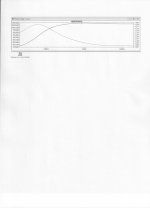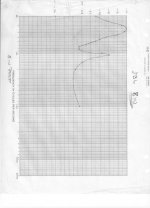Or c) Helping restore contact in joints or welds where a bit of oxide may have formed?
I suspect that is more along the lines of what was going on. They were probably dealing with 100's of amps in huge bolted together busses, working the joints would keep the drops down. I have similar experience with ocean air and 4/0 cable.
Frequency designations, Demian?
The AP graph has them along the bottom in the standard Log sequence. I don't have the Excel plot handy.
Susceptibility to external influence is generally broken into two categories, when the victim has an impedance below 377 ohms, and when it is above 377 ohms. That is the free space impedance for planar wave propagation.
Above, capacitance is generally the domimant, below magnetic dominates. I believe that was also included in the Tom Van Doren link I provided earlier.
I kind of think it's more for dissipation. These puppies are getting harder and harder to keep cool, and the capacitive energy storage of the gates goes as the voltage squared. (cmos)
jn
377: Thanks jn
capacitive energy storage of the gates goes as the voltage squared. (cmos): OK. But does this produces heat?
Tom Van Doren link: I missed it and I can’t find it.😡
Sorry George it's known as full court press time, you sent your designs to fab and surprise, surprise they work. It's 24/7 work right now, not audio but good stuff. I think others have capture the gist, there is a transition from lumped to continuous models that requires judgement based on several factors. Importantly the skin effect is fractional f in nature and does not plug into a normal simulation environment.
It’s good to know that good stuff exists 😀 outside of audio.
On a later time when you will be less overworked, we will revisit the issue (surface charges distribution rel. time). You do have the charisma to hint to important thinks in a minimum of words

I wish. 🙁 He's working, I'm packing up house for a move.
I hope you don’t hate packing up as much as I do.
Wish you well.

George
OK, I will find another example.
Just go over to Stereophile's website, John. JA's been using an AP rig for publishing measurements for years.
se
Does anybody notice that the FINE gradations are lost in the AP and many other computer generated graphs? I got used to those FINE gradations, and I miss them.
John:
What do you want to see that the AP plot does not show? The .01 dB lines are missing but I believe they can be added. Further it can be imported to Excel with lots of plotting options. More important is presenting the important data clearly. The LF region below 200 Hz is -.3 dB at 30 Hz max. in the plot. Do you need more detail?
What do you want to see that the AP plot does not show? The .01 dB lines are missing but I believe they can be added. Further it can be imported to Excel with lots of plotting options. More important is presenting the important data clearly. The LF region below 200 Hz is -.3 dB at 30 Hz max. in the plot. Do you need more detail?
It is just a personal thing, Demian. Besides, you have an AP and I don't, NOR can I afford one, even if I wanted to learn how to use it. By the way, my new PC is up and running. We should talk about spice models, etc.
...NOR can I afford one...
I'm sure Parasound could afford it.
se
While Parasound can afford it they won't supply John. Its the curse of being a consultant.
I can't afford an AP and would get thrown out of the house if I did buy an AP. The ROI is not high enough. The Boontons cost less than $300 (My max budget for any of this stuff) and have a low enough distortion floor for most applications. If it were important there is usually a way. For bench work any box that is working OK is good enough since real world products are no better than these measurement systems. Its just that age and abuse from the original owner usually takes a major toll on the stuff.
I can't afford an AP and would get thrown out of the house if I did buy an AP. The ROI is not high enough. The Boontons cost less than $300 (My max budget for any of this stuff) and have a low enough distortion floor for most applications. If it were important there is usually a way. For bench work any box that is working OK is good enough since real world products are no better than these measurement systems. Its just that age and abuse from the original owner usually takes a major toll on the stuff.
Thank you for clueing in SE, Demian. He just does not seem to understand that the money is not available like it used to be. In any case, Demian, what do you recommend for a Spice program?
Sorry Demian, I thought that you had an AP, yourself. Well, does Peter have one, or does he use Tex's?
While Parasound can afford it they won't supply John. Its the curse of being a consultant.
Consultant my ***. Parasound's entire Halo line centers on John's celebrity. John's abilities as a designer are a distant second as far as Parasound's concerned.
JC 3: John Curl’s newest phono preamp design
JC 2: Audio circuits designed by John Curl & CTC Builders
A 51: Circuitry designed by legendary John Curl
A 52: Circuitry designed by legendary John Curl
A 31: Circuitry designed by legendary John Curl
JC 1: Designed by legendary John Curl and CTC Builders
A 21: Circuitry designed by legendary John Curl
A 23: Circuitry designed by legendary John Curl
John's selling his celebrity. That's leverage. "No AP, no JC. Oh yeah, and no brown M&M's!"
John's a celebrity. He needs an agent.
se
I heard that aliens will destroy Bay Bridge this outumn, but I don't believe that new one will be finished in this year.
looks like the main support is lit at night -
An externally hosted image should be here but it was not working when we last tested it.
yesterdays movie -
http://scienceview.berkeley.edu/view/images/newview.jpg?1339479271928
An externally hosted image should be here but it was not working when we last tested it.
Last edited:
celebrity.
John's a celebrity.
He needs an agent.
speaking engagements?
these people would be the best bet -
William Morris Endeavor Entertainment - Concerts, Tours, and Appearances
WME
- Status
- Not open for further replies.
- Home
- Member Areas
- The Lounge
- John Curl's Blowtorch preamplifier part II

